DUKAS Complete Piano Music (Vincenzo Maltempo)
View record and artist detailsRecord and Artist Details
Genre:
Instrumental
Label: Piano Classics
Magazine Review Date: 03/2023
Media Format: CD or Download
Media Runtime: 74
Mastering:
DDD
Catalogue Number: PCL10171

Tracks:
| Composition | Artist Credit |
|---|---|
| Sonata for Piano |
Paul (Abraham) Dukas, Composer
Vincenzo Maltempo, Piano |
| Variations, interlude et final sur un thème de R |
Paul (Abraham) Dukas, Composer
Vincenzo Maltempo, Piano |
| Prélude élégiaque |
Paul (Abraham) Dukas, Composer
Vincenzo Maltempo, Piano |
| (La) Plainte, au loin, du faune |
Paul (Abraham) Dukas, Composer
Vincenzo Maltempo, Piano |
Author: Peter J Rabinowitz
Dukas’s high-minded fin de siècle Piano Sonata is a series of paradoxes. It’s the culmination of the 19th century’s ‘grand statement’ tradition stemming from Beethoven’s Hammerklavier and continuing through the Alkan and Liszt Sonatas, yet it sounds like none of its obvious forebears. It’s severely classical in design, yet it pushes beyond romanticism in its embrace of extreme chromaticism. It calls for a high level of virtuosity, yet outside the Scherzo it offers few flashy opportunities to show off.
While it’s widely admired by connoisseurs, its demands, both intellectual and physical, are such that only the committed dare take it on. As a consequence, while performances are rare, they’re generally good, and competition is fierce. Maltempo more than holds his own. As we’d expect from his keen-edged Alkan (Toccata Classics, Piano Classics), he has the dexterity to clarify Dukas’s thick textures. Then, too, the pounce of his left-hand octaves gives vigour to passages that can easily turn turgid; and his control of voicing and articulation allows him to give shape to the rapid-fire perpetual motion of the outer sections of the third movement, which can easily blur. But he offers depth as well as focus: he’s attentive to Dukas’s idiosyncratic harmonic idiom (listen, for instance, to how he handles the unusual chordal progression that opens the finale), and he plays with a rich timbral palette.
Each of the other three works makes substantially different demands, and Maltempo’s performances reveal his versatility. Because of his quick reaction time, he can deftly negotiate the Variations’ kaleidoscopic shifts of perspective; his refinement gives the Prélude (a cross between Debussy’s ‘Cathédrale engloutie’ and Messiaen) a poignant afterglow. Best of all is the acuity that allows him to harmonise the three voices in the Plainte – which filters Tristan through Debussy and then again through Dukas – in a way that intensifies its mournful sense of timelessness.
If you’re looking for the Sonata alone, you might check out Marc-André Hamelin, whose ability to give each inner line its own colour and resilience brings out Dukas’s polyphony with even more lucidity than Maltempo can muster. Hamelin is also more attuned to the music’s romantic underpinnings. But if you’re looking for Dukas’s ‘complete’ piano music (except for the brief unpublished Allegro that Dukas wrote for Koussevitzky, included on Marco Rapetti’s plain-spoken collection), this solidly engineered album will serve you extremely well.
Discover the world's largest classical music catalogue with Presto Music.

Gramophone Digital Club
- Digital Edition
- Digital Archive
- Reviews Database
- Full website access
From £8.75 / month
Subscribe
Gramophone Full Club
- Print Edition
- Digital Edition
- Digital Archive
- Reviews Database
- Full website access
From £11.00 / month
Subscribe
If you are a library, university or other organisation that would be interested in an institutional subscription to Gramophone please click here for further information.




